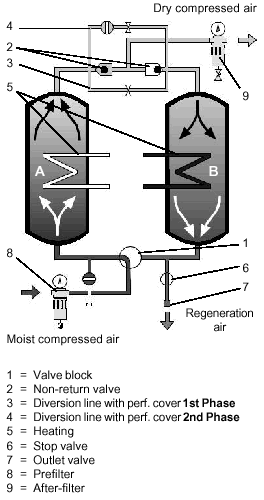<BR> Fig. 5.14:
Op. diagram of an adsorption dryer,
internal hot regeneration
Fig. 5.14:
Op. diagram of an adsorption dryer,
internal hot regeneration | 1st Phase
Drying tank B is slowly heated by the internal heating to the necessary regeneration temperature. If the regeneration temperature is exceeded, the moisture releases itself from the adsorption material. Approx. 2- 3 % of the dried flow of compressed air from the compressor relaxes and at slight pressure is directed through a diversion line through drying tank B. This flow of regeneration air absorbs the moisture and directs it out into the open through an outlet valve.
2nd Phase
In a cooling phase the operating pressure drops back to the temperature of the drying bed. A second diversion line opens for this purpose. Appro x. 5 % of the compressor FAD is directed through drying tank B. The internal heating is no longer operating at this point.
Features
- Economical with high volume flows.
- Simple dryer construction.
- Little dried compressed air is required to regenerate the dryer.
- Prefiltration of intake air.
A pre-filter removes most of the oil, water droplets and dirt particles from the compressed air.
- Postfiltration of dried compressed air.
Drying materials taken with the compressed air from the drying tank must be filtered out of the compressed air.
|